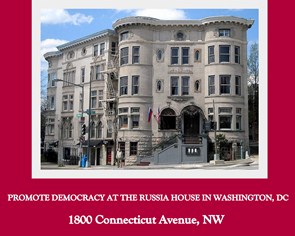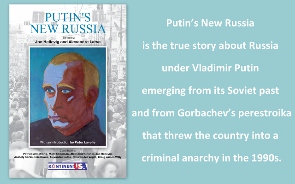
 Nestled in Washington’s forested Rock Creek Park, parts of an estate that once belonged to an American millionaire feel like a Russian noble mansion. But Marjorie Merriweather Post, the heiress of a famous cereal company fortune who had a passion for Russian imperial art, wanted it that way.
Nestled in Washington’s forested Rock Creek Park, parts of an estate that once belonged to an American millionaire feel like a Russian noble mansion. But Marjorie Merriweather Post, the heiress of a famous cereal company fortune who had a passion for Russian imperial art, wanted it that way.Instead of bequeathing the home to her children when she died in 1973, Post had decided that the estate would be turned into a museum.
Known to be one of the wealthiest women in America, Post had amassed a prodigious collection of Russian imperial art when she lived in the Soviet Union from 1937 to 1938 with her third husband, US Ambassador Joseph Davies, a wealthy lawyer. Today, the mansion, known as "Hillwood Estate, Museum & Gardens,” boasts what it calls "the most comprehensive collection of Russian imperial art outside of Russia.”
Despite critics’ claims that some of the artworks Davies and Post had acquired were seized from Russian citizens by Soviet authorities after the 1917 revolution, the pieces at Hillwood still make up an impressive collection. Even after the couple left Moscow in 1938, and divorced in 1955, Post continued acquiring Russian art through dealers and at auction.
Here are 20 impressive Russian imperial pieces that Post collected throughout her life, and which are on permanent display at the Hillwood Museum.
1. Catherine the Great Easter Egg. An elaborate Fabergé egg made of gold, diamonds, pearls, silver, platinum and glass. Created by Henrik Wigström, the last head workmaster at the famous House of Fabergé jewelry firm, this piece also has hidden compartments. The egg was created for Tsar (Emperor) Nicholas II as an Easter present for his mother in 1914.

Credit: Hillwood Estate, Museum and Gardens
2. Twelve Monogram Egg. A gold Fabergé egg, covered in blue enamel and diamonds, that was presented by Tsar Alexander III to his wife in 1895. Rows of diamonds divide this egg into twelve panels, each of which is adorned by the crowned initials of either Alexander or his wife, Maria Fedorovna. Areas of the enamel were intricately carved out to reveal the gold beneath. In 1885, the tsar initiated the custom of presenting his wife with a Fabergé egg each Easter, a custom which his son continued.

Credit: Hillwood Estate, Museum and Gardens
3. Fabergé clock. An 18th century silver rococo-style clock, with secret panels, that belonged to Empress Maria Fedorovna, mother of Tsar Nicholas II. According to legend, Maria admired the original version of this clock, which was designed by English craftsman James Cox for Empress Alexandra, Nicholas’ wife. The royal couple then commissioned Fabergé to create a copy of the chest-of-drawers-style timepiece, to which he added side panels that reveal portraits of Nicholas and Alexandra.

Credit: Hillwood Estate, Museum and Gardens
The eggs and clock are housed in Hillwood’s Icon Room, which includes 400 priceless Russian objects. The imperial Fabergé eggs account for two of the remaining 42 in the world.

Credit: Hillwood Estate, Museum and Gardens
4. Military Presentation Cup. A solid gold military cup designed in Russian neoclassic style that was presented to General-Adjutant Count Stepan Fedorovich Apraksin in 1833. Apraksin took part in the Russian war against Napoleon in 1812 and went on to a have distinguished military career for the crown. Throughout his reign, Nicholas I commemorated military achievements by commissioning exceptional gifts such as this one for members of his armed forces. The handle of the cup’s lid is carved in fine detail to resemble the plumed helmet of the Imperial House Guards.

Credit: Hillwood Estate, Museum and Gardens
5. Nuptial crown. A diamond-studded crown worn by Empress Alexandra at her 1894 wedding to Emperor Nicholas II. Diamonds are sewn onto the velvet-covered supports, and a cross of six larger, old mine-cut diamonds surmounts it. The six bands, and the single one connecting them on the bottom, are formed by three rows of smaller diamonds with two rows of larger ones in between.

Credit: Hillwood Estate, Museum and Gardens
6. A Boyar Wedding Feast. Created in 1883, this large oil painting that measures nearly 13 feet (or about four meters) wide depicts a wedding feast uniting two families of the powerful boyar class that dominated Muscovite politics in the 16th and 17th centuries. The artist, Konstantin Makovsky, singled out that moment during the wedding feast when the guests toast the new couple with the traditional chant of "gor’ko, gor’ko," meaning "bitter, bitter," a reference to the wine, which has supposedly turned bitter. According to tradition, the newlyweds must kiss to make the wine sweet again. The toast occurs towards the end of the feast when a roasted swan is brought in, the last dish presented before the couple retires.

Credit: Hillwood Estate, Museum and Gardens
7. St. Petersburg chalice. Commissioned by Catherine the Great for the Trinity Cathedral in St. Petersburg, this 18th century chalice is made of gold, diamonds, and precious stones. The empress commissioned Iver Windfeldt Buch to produce two liturgical sets, each comprising of a chalice and several other pieces necessary for religious rituals. One set, which included this chalice, was created for the Trinity Cathedral, while the other was used in the Dormition Cathedral in the Moscow Kremlin. To construct the set, Catherine provided Buch with gold and diamonds from the state treasury.

Credit: Hillwood Estate, Museum and Gardens
8. Portrait of Catherine the Great. In this oil painting by Dmitrii Grigorievich Levitskii, Catherine II directs her royal scepter toward the imperial crown, orb, and a bust of Peter the Great. Celebrated artists and anonymous painters alike created multiple copies of such stock portraits, and they were hung in official departments, residences of provincial governors, as well as educational and social institutions of which the empress served as the patron. In this case, the portrait, which is nearly nine feet (three meters) tall, was presented in 1788 as a reward to a British financial adviser of the empress.

Credit: Hillwood Estate, Museum and Gardens
9. Portrait of Countess Samoilova. Famed Russian artist Karl Briullov, known as a key figure in his country’s artistic transition from neoclassicism to romanticism, painted this portrait of his friend, Countess Julia Samoilova, in Italy. The painting, measuring nearly nine feet (3 meters) tall, is described by Hillwood Museum as "perhaps the artist’s most important work in a museum outside Russia.” To Briullov, the wealthy countess epitomized femininity and beauty, and he portrayed her in a scene of joyful welcome and fashionable elegance.

Credit: Hillwood Estate, Museum and Gardens
10. Enamel box. Thirty rose-cut diamonds in high setting surround a portrait of Tsar Alexander II on this elaborate miniature enamel box made around 1870.

Credit: Hillwood Estate, Museum and Gardens
11. Music box. A gift to their parents for their 25th wedding anniversary from Princes Felix and Nikolai Yusupov in 1907. Felix was best known for his participation in the murder of Grigori Rasputin, the spiritual healer who also became an intimate confidante of Tsar Nicholas II and Tsaritsa Alexandra. Rasputin was killed at the Yusupov’s royal family mansion, the Moika Palace in St. Petersburg, which is depicted on this box.

Credit: Hillwood Estate, Museum and Gardens
12. Bread and salt dish. Artisans at the preeminent silversmith firm of Pavel Ovchinnikov created this ornate platter in 1883 that has miniature paintings of Tsar Alexander III (top), his wife Tsaritsa Maria Fedorovna (right), and a young Nicholas II (left).

Credit: Hillwood Estate, Museum and Gardens
13. Collar of the Order of Saint Andrew First Called. A 19th century chain that was awarded to members of the imperial family, foreign royalty, and to important servants of the state. Worn on special ceremonial occasions, the chain is made up of various medallions, including ones that depict a double-headed eagle, the Russian empire’s symbol that it looked both to the East and West. A large medallion at the bottom depicts St. Andrew martyred on an X-shaped cross.

Credit: Hillwood Estate, Museum and Gardens
14. Ebonized wood chest. A gift presented by Tsar Alexander II to a Russian duke and his wife their wedding anniversary in the 19th century, this wooden cabinet was originally designed with four portraits on the front panels that depicted the duke and his family. When it arrived to Mrs. Post from the Soviet Union with the images removed, she had lapis panels installed to replace the missing portraits.

Credit: Hillwood Estate, Museum and Gardens
15. Catherine Palace glass chandelier. Believed to be from the Catherine Palace in Tsarskoye Selo, Russia, this chandelier ushered in a new era in Russian glassmaking with its whimsical style and bright colors. Post hung it in her breakfast room, where it still remains.

Credit: Hillwood Estate, Museum and Gardens
16. Candelabra. Likely used in the Winter Palace in St. Petersburg, these 41-inch (104-cm) candelabra from the 19th century depict the Greek goddess of victory, each perched on top of a lapis lazuli column.

Credit: Hillwood Estate, Museum and Gardens
17. Mother of God icon. This icon of the Virgin Mary with the baby Jesus is a 17th century copy of one discovered in Kazan in 1579. The original icon was credited with helping Russian troops liberate Moscow from Polish occupying forces in 1612.

Credit: Hillwood Estate, Museum and Gardens
18. Icon of St. George with Deesis, Saints and Martyrs. This 16th century church icon depicts the legend of St. George slaying a dragon. St. George, a venerated Christian martyr, is flanked by Jesus, Mary and archangels.

Credit: Hillwood Estate, Museum and Gardens
19. Tea and Coffee Service. A 19th century tea set made by the Imperial Porcelain Factory in St. Petersburg. Empress Maria Fedorovna is said to have traditionally presented small tea sets as gifts to her family and friends. Although no evidence exists that this set was one of her presents, such gifts proved fashionable in the first decade of the 19th century.

Credit: Hillwood Estate, Museum and Gardens
20. Pieces from the Orlov Service. Parts of a tea set that Catherine the Great commissioned in honor of one of her lovers, Count Grigory Grigorievich Orlov in the 18th century. With his four brothers, Orlov led the coup that placed Catherine on the Russian throne in June 1762. The letters painted on the containers are Cyrillic for GGO—Orlov’s initials—and the lid handles depict romancing cherubs.

Credit: Hillwood Estate, Museum and Gardens
The tea sets are one of many in the Hillwood Museum’s Russian Porcelain Room. The Russian imperial coat of arms (the double-headed eagle) can partially be seen inlaid in the center of the floor.




.jpg/250px-ElbeDay1945_(NARA_ww2-121).jpg)





